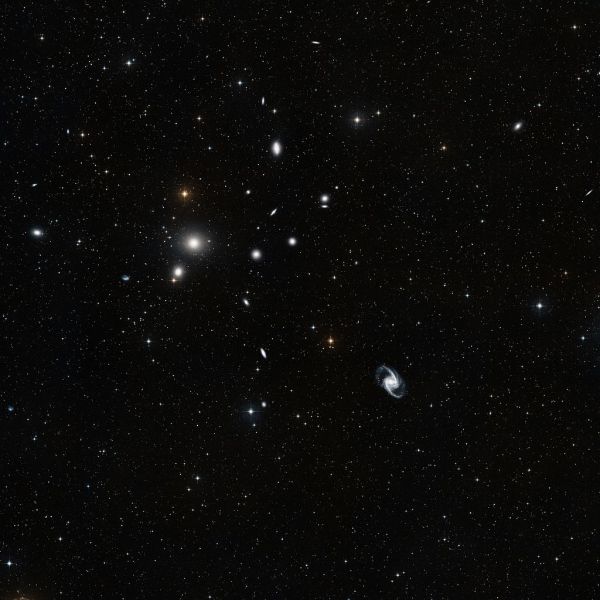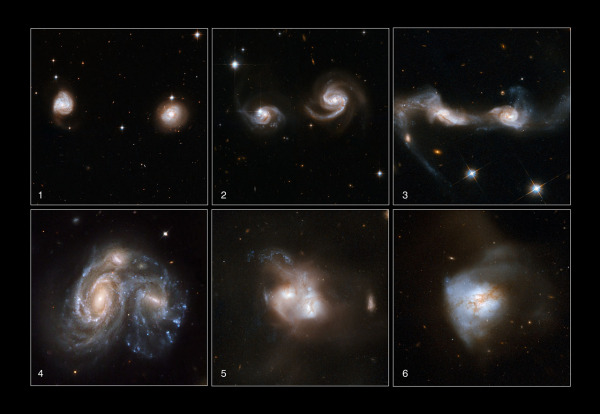“Sometimes, I sit alone under the stars
and think of the galaxies inside my
heart, and truly wonder if anyone will
ever want to make sense of all that
I am.” -Testy McTesterson
The largest galaxies in the Universe all have a few things in common: they all contain many trillions of stars, they all contain many times their stellar mass in the form of dark matter, and they're all found towards the centers of great galactic clusters.
 Image credit: ESO and Digitized Sky Survey 2. Acknowledgment: Davide De Martin. Via http://www.eso.org/public/images/eso0949m/.
Image credit: ESO and Digitized Sky Survey 2. Acknowledgment: Davide De Martin. Via http://www.eso.org/public/images/eso0949m/.
Oh, and one more thing: none of them are spiral galaxies! Why are the largest spiral galaxies in the Universe only a few times the size of our Milky Way, but the largest galaxies overall are hundreds or even a thousand times as big as our home galaxy?
- Log in to post comments


Will,
What do you think of the recent rocket based observations, which purport that the extended halos of galaxies are putting out about as much light as the central regions? If there really are a similar amount of stars that we've missed in the halos, what does this do to the ratio of dark matter to baryonic matter?
The animation was interesting, but I wonder if it's incomplete. The animation shows the galactic core rotating quite a bit faster than its outer regions. Vera Rubin's work illustrated that observations of galactic rotation did not, in fact, agree with predictions based solely on visible matter distribution, leading to the prediction of dark matter. If this simulation doesn't take dark matter into account, I wonder how its demonstration of galactic evolution would differ.
@Pau lG
' The animation shows the galactic core rotating quite a bit faster than its outer regions.'
The core and outer regions are probably traveling at the same velocity which gives this view. Consider the outer diameter has a larger distance to traverse compared to the inner diameters as you progress toward the centre of the object.
Amazing content..
Sorry for layman's guess.
I think that the type of galaxy depends on the total angular momentum of the galaxy (or some relation of the total angular momentum to the total mass). Spiral galaxies with (almost) all stars orbiting in the same direction have huge orbital momentum while elliptical galaxies with random star orbits have angular momentum close to zero. Whether galaxy merge results in elliptical or spiral galaxy depends on the angular momentum after the merge. A few month ago models of galaxy merge showed that merge of elliptical galaxies may result in spiral galaxy (and this may explain higher than expected number of spiral galaxies in the early Universe).
In addition, some astronomer (sorry, I do not remember the name) predicted that even elliptical galaxies shall have faint spiral arms and he verified it at one (and only) galaxy he studied. So may be elliptical galaxies are just galaxy bulges of giant but very dim spiral galaxies.
Ethan -- Thanks! I figured intuitively that since ellipticals tend to be the gargantuans, this suggests an evolutionary process, with spirals as the progenitors. This suggests that 'spiralness' is an early to intermediate evolutionary phase and that galactic 'style' has a strong direction which disfavors spirals and ultimately favors ellipticals over time. More important, there seems to be no mechanism to turn an elliptical back into a spiral, or a number of spirals. It seems to be a one-way street.
I like the subject of galactic evolution because it helps reduce the number of null hypotheses on the evolution of the Universe itself. The evidence shows a clear evolution from spiral ---> elliptical. The opposite process never happens: elliptical ---> spiral. Or larger galaxy -----> smaller fragment galaxies. Galactic evolution appears to be purely combinatory: galaxies combine and get bigger over time but never split apart and separate and fragment.